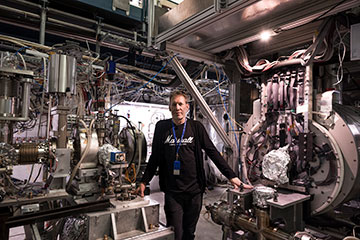![]()
An artistic illustration of the movement of an antihydrogen atom in the ALPHA magnetic trap, before (grey) and after (blue) laser cooling. [Image: Chukman So/TRIUMF]
Physicists have been making atoms of antihydrogen for more than a quarter of a century, but so far have been unable to measure their spectra with the precision of tests on ordinary hydrogen.
That could change now that researchers at the CERN laboratory in Switzerland have shown how ultraviolet laser pulses can be used to cool down antiatoms and potentially reduce the uncertainty of a key transition frequency (Nature, doi: 10.1038/s41586-021-03289-6).
The anatomy of antimatter
Atoms of antihydrogen consist of a positron (an anti-electron) bound to an antiproton. First produced in 1995, they provide a way of comparing the behavior of matter and antimatter. The idea is to make very precise measurements of their transition frequencies and compare the results with those of standard, matter-based hydrogen. Although thought unlikely by theorists, were a difference to emerge it would imply the breaking of charge–parity–time symmetry—a cornerstone of modern physics.
Currently, however, antimatter spectroscopy lacks the precision of its matter equivalent. While the 1S–2S transition frequency in normal hydrogen has been established with an uncertainty of just a few parts in 1015, the same quantity in antihydrogen is about 1,000 times less precise. This difference is largely due to the vast disparity in sample sizes—perhaps a few hundred atoms per trial in the case of antihydrogen versus the roughly 1015 available every second when carrying out experiments on normal hydrogen.
Cooling antihydrogen could do much to bridge the gap, since this can both improve precision and reduce some sources of systematic error. The very small number of atoms available rules out evaporation as a cooling method, given the rarity of collisions. So scientists instead aim to use laser-based cooling, a technique that for over 30 years has been employed to bring the temperature of ordinary matter down to fractions of a degree above absolute zero.
The idea is to direct photons of just the right frequency at antiatoms, so that the former are absorbed and impart some negative momentum to the latter. Given that the photons emitted once the atoms drop back down to their original energy level will be given off in all directions, the net result is a slowing down of the atoms. The frequency in this case corresponds to the 1S–2P Lyman-alpha transition, reduced slightly to correct for the Doppler shift of the incoming photons.
Laser cooling antiatoms

Jeffrey Hangst at the ALPHA experiment, one of the experiments at CERN’s Antiproton Decelerator. [Image: Maximilien Brice/CERN]
The Antihydrogen Laser Physics Apparatus (ALPHA) experiment at CERN makes antiatoms by using electromagnetic traps to collect and then combine antiprotons from the lab’s Antiproton Decelerator with positrons from a source of sodium-22. It is then able to hold the neutral atoms in place with magnets, thanks to the particles’ tiny magnetic dipole moments.
In the latest work, Jeffrey Hangst of Aarhus University in Denmark and colleagues in the ALPHA collaboration cool these atoms down using pulses of vacuum ultraviolet light from a purpose-built laser. As Hangst points out, generating and distributing such radiation is very demanding as there are no readily available lasers or nonlinear crystals at these wavelengths while the light doesn’t propagate through air.
The solution devised by collaboration member Takamasa Momose of the University of British Columbia in Canada involves seeding two titanium-sapphire crystals with tunable 730-nm radiation from a diode laser while pumping them with nanosecond pulses from a Nd:YAG laser. The resulting pulses are frequency doubled in a beta barium borate crystal, with the third harmonic of that output then generated in a high-pressure krypton-argon gas cell. The upshot is pulses whose wavelength can be varied around the 121.6 nm of the Lyman-alpha transition.
Probing transition frequencies
ALPHA has already employed the laser to excite this particular transition as well as measure antihydrogen’s fine structure and Lamb shift. But the latest research marks the first time that such a device has been used to cool antiatoms. ALPHA achieved this after raising the number of antihydrogen atoms it can store in its trap at any one time. It can now generate between 10 and 30 antiatoms every four minutes and then combine the particles from different batches over the course of several hours to yield around 1,000 antiatoms altogether.
By slightly detuning the laser toward both the red and blue, and then comparing the width of the resonance in each case, Hangst and colleagues found they could reduce antiatoms’ velocity along the laser axis. What’s more, by recording how long it took antiatoms to reach the trap walls and annihilate, they also discovered a significant reduction in atoms’ transverse velocity—implying cooling in three dimensions. This, they say, was probably due to an asymmetry in the trap’s magnetic potential.
In addition, the researchers used the cooled antiatoms to probe the 1S–2S transition. They found that the spectral line in that case was about four times narrower than it would be without laser cooling.
Future work
Being able to produce smaller, denser and colder samples of antihydrogen, Hangst and his colleagues argue, will also benefit research that uses these atoms to probe any difference in the gravitational behavior of matter and antimatter. Beyond that, they add, the ability to manipulate the motion of antiatoms could lead to antimatter fountains for the creation of interferometers as well as antimatter molecules.
The ALPHA researchers are currently upgrading their laser system to increase the energy and rate of its pulses. They say they have yet to optimize either the detuning frequency or their trap’s magnetic-field configuration, and suggest that these parameters could be varied in time during the course of an experimental run.
First, however, the researchers need to gain access again to CERN’s antiprotons—not having had any time with the beam since 2018.
